 Technology peripherals
Technology peripherals
 AI
AI
 A800 significantly surpasses Llama2 inference RTX3090 and 4090, performing excellent latency and throughput
A800 significantly surpasses Llama2 inference RTX3090 and 4090, performing excellent latency and throughput
A800 significantly surpasses Llama2 inference RTX3090 and 4090, performing excellent latency and throughput
Large-scale language models (LLMs) have made tremendous progress in both academia and industry. But training and deploying LLM is very expensive and requires a lot of computing resources and memory, so researchers have developed many open source frameworks and methods for accelerating LLM pre-training, fine-tuning, and inference. However, the runtime performance of different hardware and software stacks can vary significantly, making it difficult to choose the best configuration.
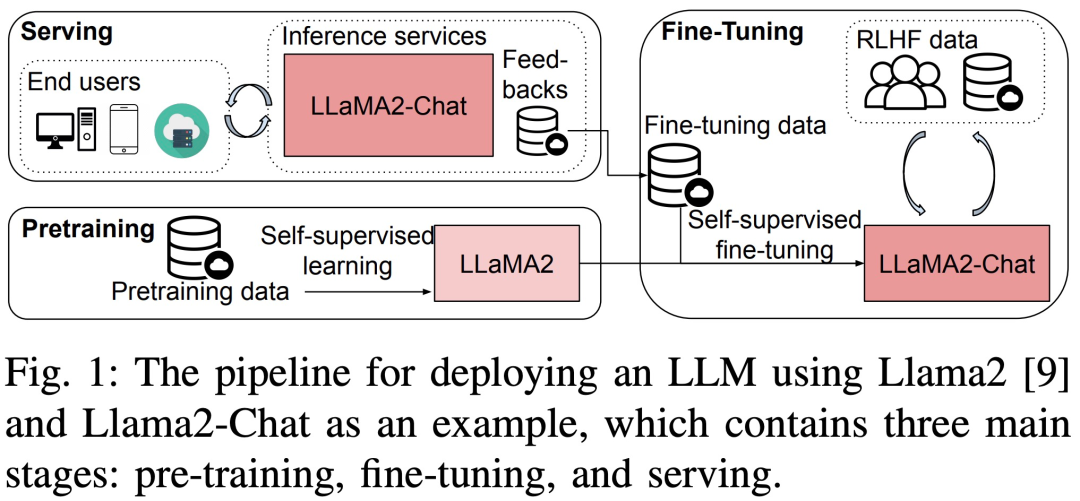
Recently, a new paper titled "Dissecting the Runtime Performance of the Training, Fine-tuning, and Inference of Large Language Models" The runtime performance of LLM training, fine-tuning, and inference is analyzed in detail from macro and micro perspectives.
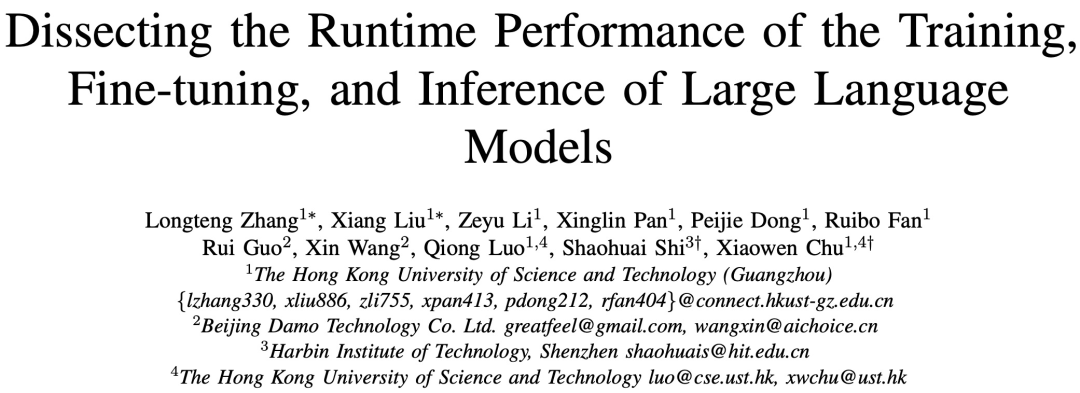
Please click the following link to view the paper: https://arxiv.org/pdf/2311.03687.pdf
Specifically, this study first conducted a full-process performance benchmark test on LLM of different sizes (7B, 13B and 70B parameters) on three 8-GPUs for pre-training, fine-tuning and service without changing the original meaning. . The tests covered platforms with and without individual optimization technologies, including ZeRO, Quantize, Recalculate, and FlashAttention. The study then further provides a detailed runtime analysis of sub-modules of computation and communication operators in LLM
Method Introduction
The study The benchmark test adopts a top-down approach, covering the end-to-end step time performance, module-level time performance and operator time performance of Llama2 on three 8-GPU hardware platforms, as shown in Figure 3.
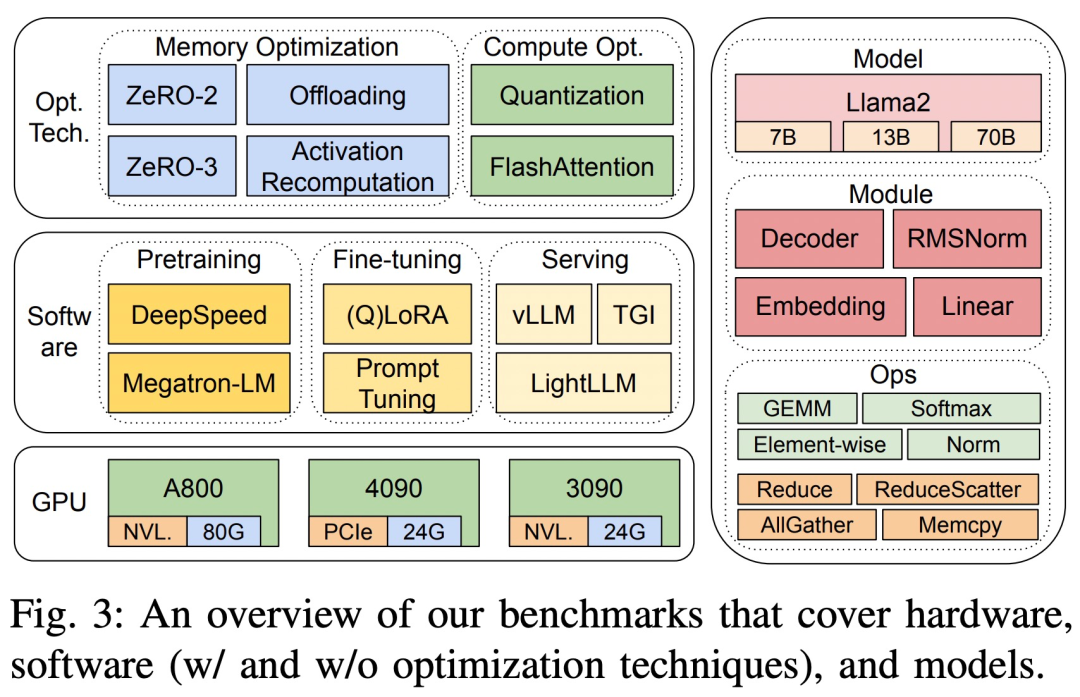
The three hardware platforms are RTX4090, RTX3090 and A800. The specific specifications are shown in Table 1 below.
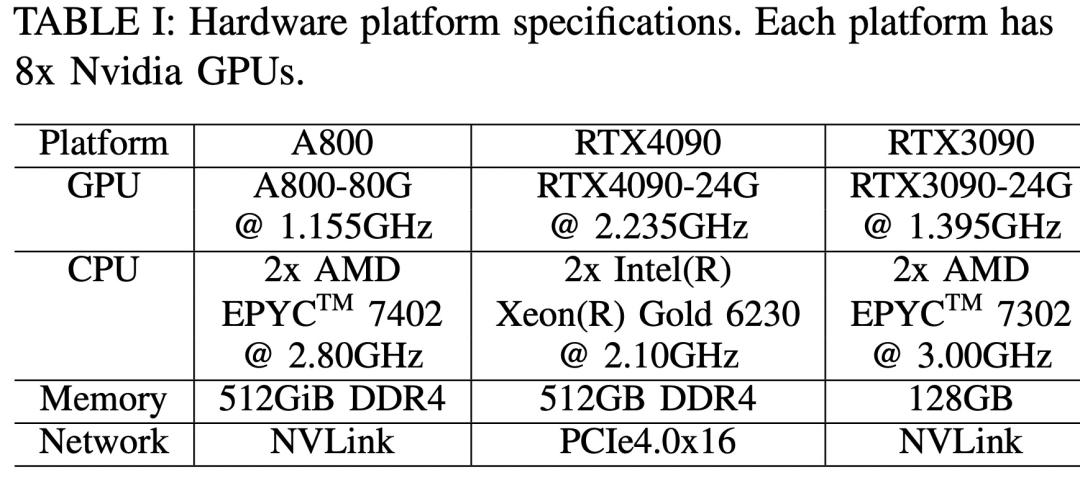
On the software side, the study compares DeepSpeed and Megatron-LM end-to-end in terms of pre-training and fine-tuning step time. To evaluate optimization techniques, the study used DeepSpeed to enable the following optimizations one by one: ZeRO-2, ZeRO-3, offloading, activation recomputation, quantization, and FlashAttention to measure performance improvements and reductions in time and memory consumption.
In terms of LLM services, there are three highly optimized systems, vLLM, LightLLM and TGI, and this study compared their performance (latency and throughput) on three test platforms .
In order to ensure the accuracy and reproducibility of the results, this study calculated the average length of instructions, inputs and outputs of the commonly used LLM data set alpaca, that is, 350 tokens per sample, And randomly generate strings to achieve a sequence length of 350.
In the inference service, in order to comprehensively utilize computing resources and evaluate the robustness and efficiency of the framework, all requests are scheduled in burst mode. The experimental data set consists of 1000 synthetic sentences, each sentence contains 512 input tokens. This study always maintains the "maximum generated token length" parameter in all experiments on the same GPU platform to ensure the consistency and comparability of results.
No need to change the original meaning, the whole process performance
This study passed pre-training and fine-tuning And infer the step time, throughput and memory consumption of Llama2 models of different sizes (7B, 13B and 70B) to measure the full performance on the three test platforms without changing the original meaning. Three widely used inference serving systems: TGI, vLLM, and LightLLM are also evaluated, focusing on metrics such as latency, throughput, and memory consumption.
Module Level Performance
LLM usually consists of a series of modules (or layers) , these modules may have unique computing and communication characteristics. For example, the key modules that make up the Llama2 model are Embedding, LlamaDecoderLayer, Linear, SiLUActivation, and LlamaRMSNorm.
Pre-training results
In the pre-training experiment session, the researcher first analyzed the pre-training of different size models (7B, 13B and 70B) on three test platforms performance (iteration time or throughput, memory consumption), and then micro-benchmarks at module and operational levels were conducted.
No need to change the original meaning, the whole process performance
The researchers first conducted experiments to compare The performance of Megatron-LM and DeepSpeed, both of which did not use any memory optimization technology (such as ZeRO) when pre-training Llama2-7B on the A800-80GB server.
They used a sequence length of 350 and provided two sets of batch sizes for Megatron-LM and DeepSpeed, from 1 to the maximum batch size. The results are shown in Table II below, benchmarked against training throughput (tokens/second) and consumer GPU memory (in GB).
The results show that when the batch size is 1, Megatron-LM is slightly faster than DeepSpeed. However, DeepSpeed is the fastest in training speed when the batch size reaches its maximum. When the batch sizes are the same, DeepSpeed consumes more GPU memory than the tensor parallel-based Megatron-LM. Even with small batch sizes, both systems consumed significant amounts of GPU memory, causing memory overflow on the RTX4090 or RTX3090 GPU servers.
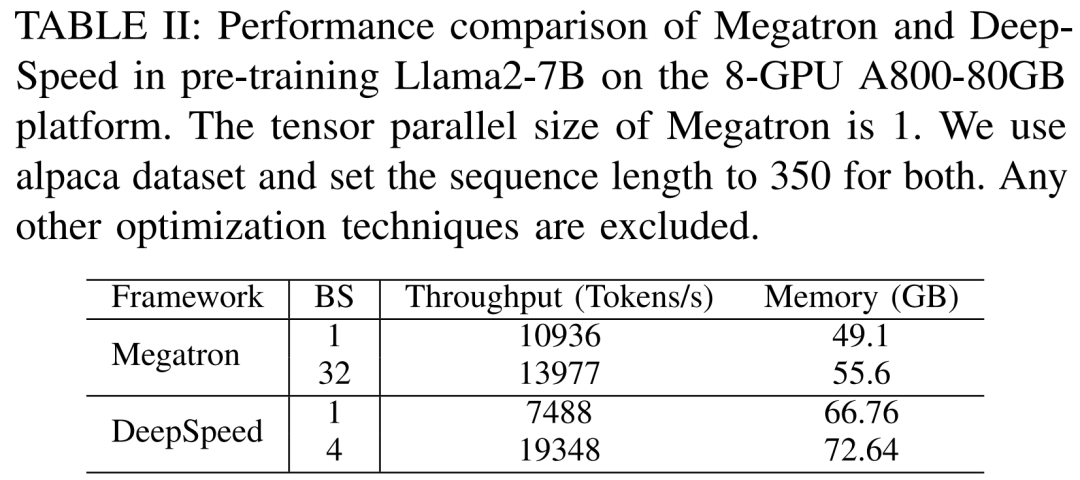
When training Llama2-7B (sequence length 350, batch size 2), the researcher used DeepSpeed with quantization to study Scaling efficiency on different hardware platforms. The results are shown in Figure 4 below. The A800 scales almost linearly, and the scaling efficiency of RTX4090 and RTX3090 is slightly lower, at 90.8% and 85.9% respectively. On the RTX3090 platform, NVLink connections are 10% more efficient than without NVLink.
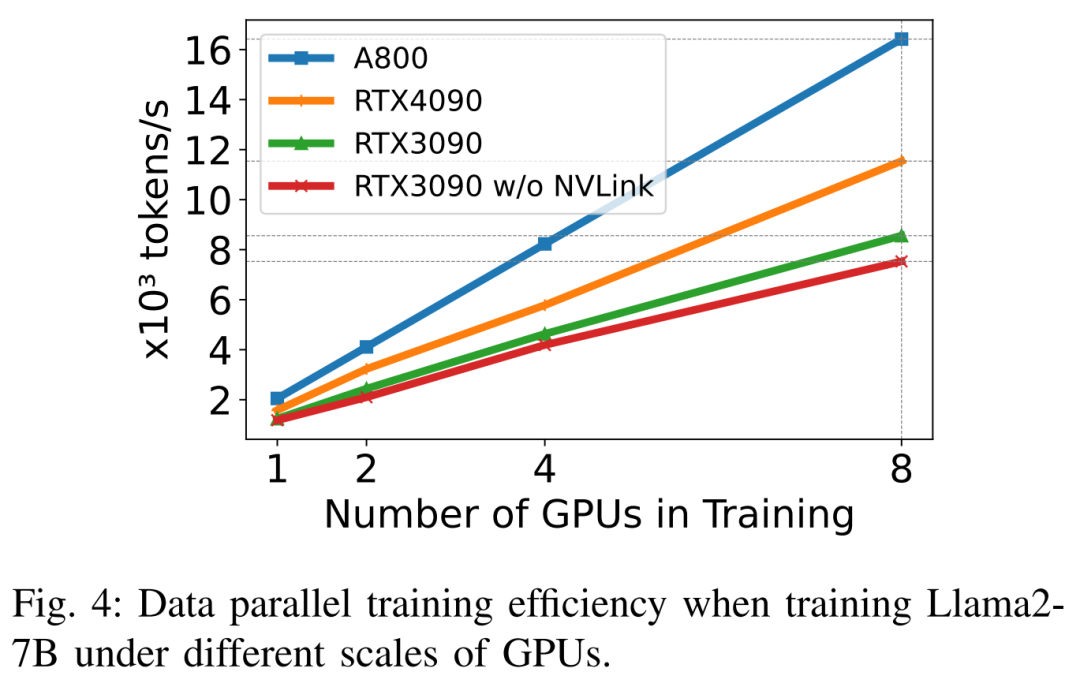
Researchers used DeepSpeed to evaluate training performance under different memory and computationally efficient methods. For fairness, all evaluations are set to a sequence length of 350, a batch size of 1, and a default loaded model weight of bf16.
For ZeRO-2 and ZeRO-3 with offloading capabilities, they offload the optimizer state and optimizer state model to CPU RAM respectively. For quantization, they used a 4bits configuration with dual quantization. Also reported is the performance of the RTX3090 when NVLink is disabled (i.e. all data is transferred over the PCIe bus). The results are shown in Table III below.

#To obtain maximum throughput, the researchers further utilized the computing power of different GPU servers by maximizing the batch size for each method. The results are shown in Table IV, showing that increasing the batch size can easily improve the training process. Therefore, GPU servers with high bandwidth and large memory are more suitable for full-parameter mixed precision training than consumer-grade GPU servers
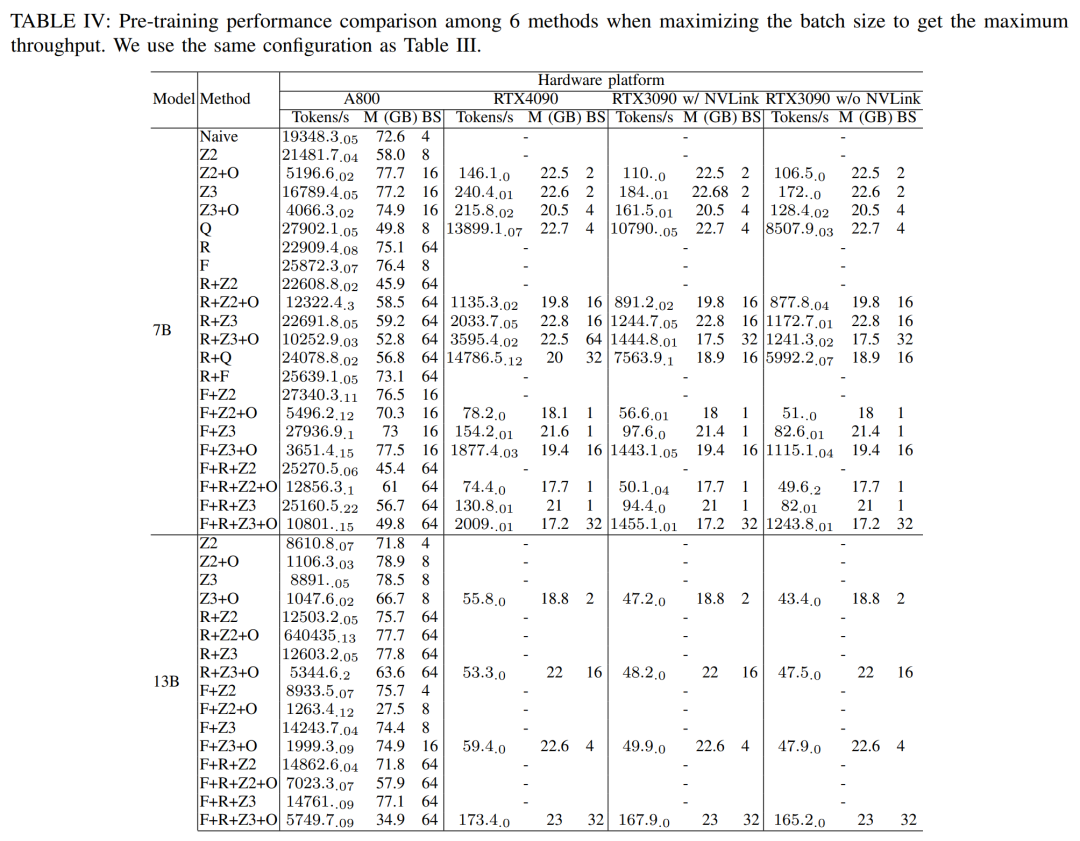
Module level analysis
Table V below shows the overall and computational core time of the forward, backward and optimizer of the single-step pre-trained Llama2-7B model cost. For the backward phase, since the total time includes non-overlapping time, the computational core time is much smaller than the forward phase and optimizer. If the non-overlapping time is removed from the backward phase, the value becomes 94.8.

##Need to recalculate and re-evaluate the impact of FlashAttention
Techniques for accelerating pre-training can be roughly divided into two categories: saving memory, increasing batch size, and accelerating computing cores. As shown in Figure 5 below, the GPU spends 5-10% of its time idle during the forward, backward, and optimizer phases.
The researchers believed this idle time was due to smaller batch sizes, so they tested all techniques with the largest batch sizes available. Ultimately, they used recalculation to increase the batch size and used FlashAttention to speed up core analysis
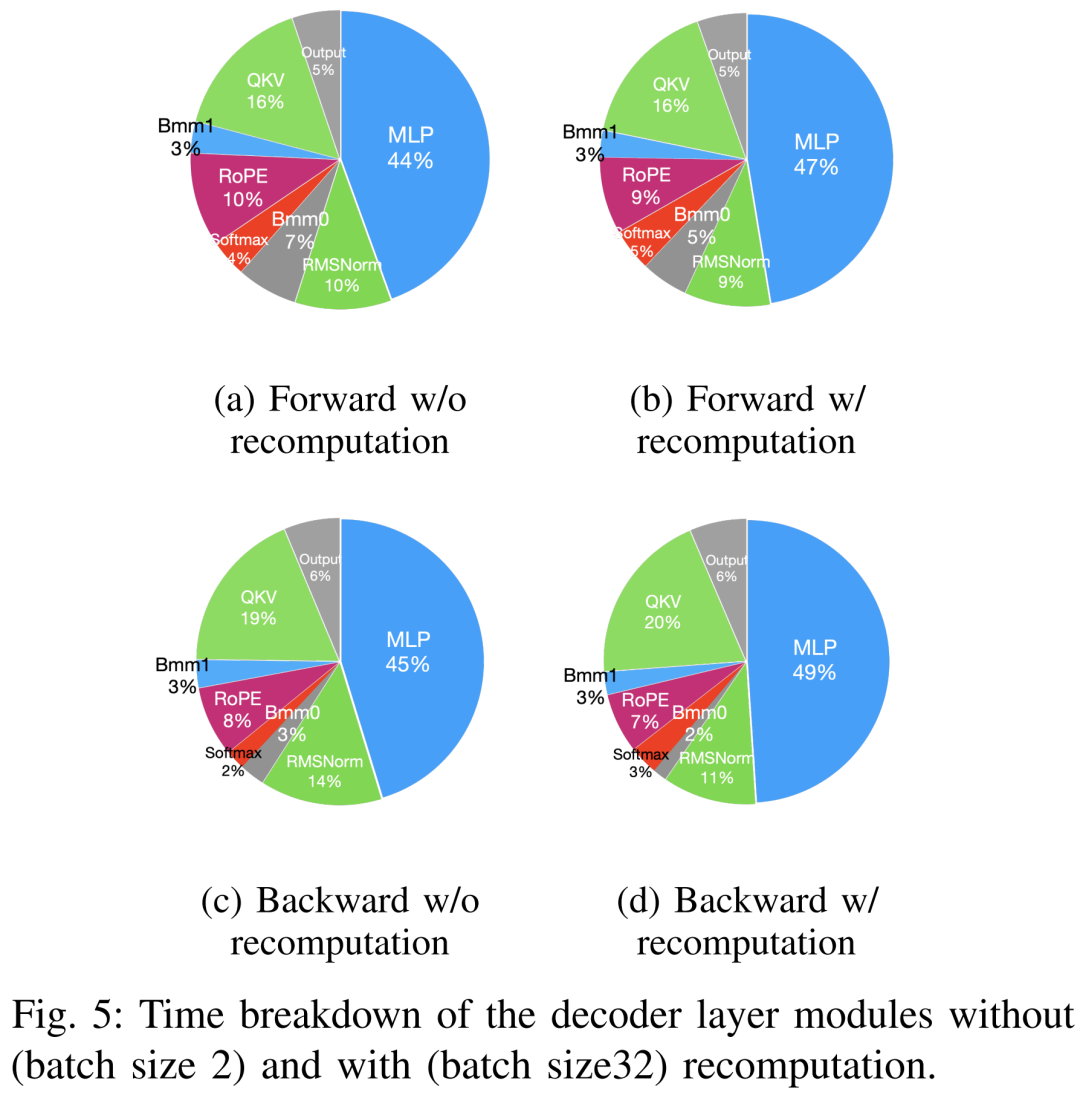
As shown in Table VII below, as the batch size increases, the time of the forward and backward phases increases significantly, leaving almost no GPU idle time.

According to Table VIII below, FlashAttention can accelerate the forward and backward attention modules by 34.9% and 24.7% respectively

Fine-tuning results
In the fine-tuning session, the researchers mainly discussed the parameter efficient fine-tuning method (PEFT) and demonstrated LoRA and QLoRA Fine-tuned performance under various model sizes and hardware settings. Use a sequence length of 350, a batch size of 1, and load the model weights into bf16 by default.
According to the results in Table IX below, the performance trends after fine-tuning Llama2-13B using LoRA and QLoRA are consistent with Llama2-7B. Compared with Llama2-7B, the throughput of fine-tuned Llama2-13B dropped by about 30%
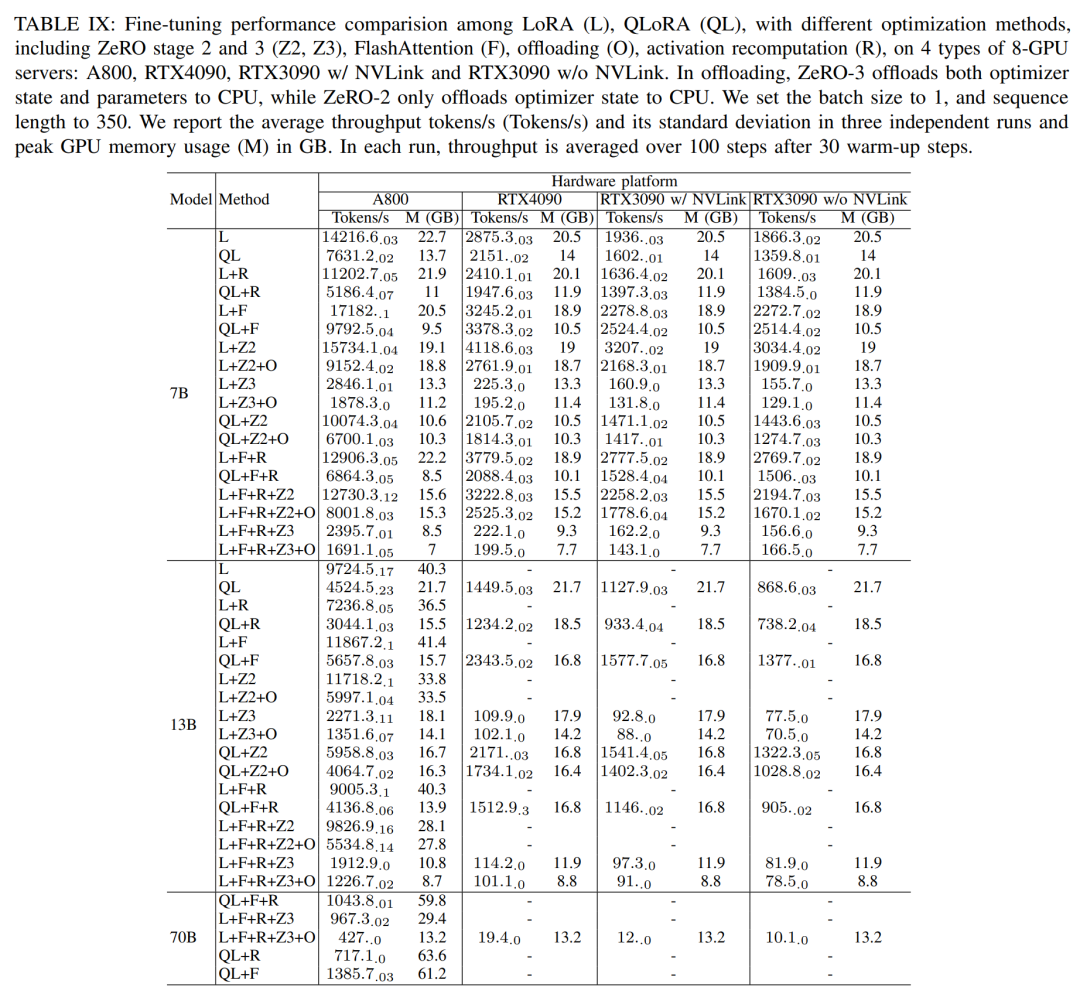
However, when all optimization techniques are combined, Even RTX4090 and RTX3090 can fine-tune Llama2-70B to achieve a total throughput of 200 tokens/second.
Inference results
No need to change the original meaning, full performance
Figure 6 below shows a comprehensive analysis of throughput under various hardware platforms and inference frameworks, in which the relevant inference data of Llama2-70B is omitted. Among them, the TGI framework demonstrated excellent throughput, especially on GPUs with 24GB of memory such as the RTX3090 and RTX4090. In addition, LightLLM significantly outperforms TGI and vLLM on the A800 GPU platform, with throughput almost doubling.
These experimental results show that the TGI inference framework has excellent performance on the 24GB memory GPU platform, while the LightLLM inference framework exhibits the highest throughput on the A800 80GB GPU platform. This finding suggests that LightLLM is optimized specifically for the A800/A100 series of high-performance GPUs.

The delay performance is shown in Figures 7, 8, 9 and 10 under different hardware platforms and reasoning frameworks
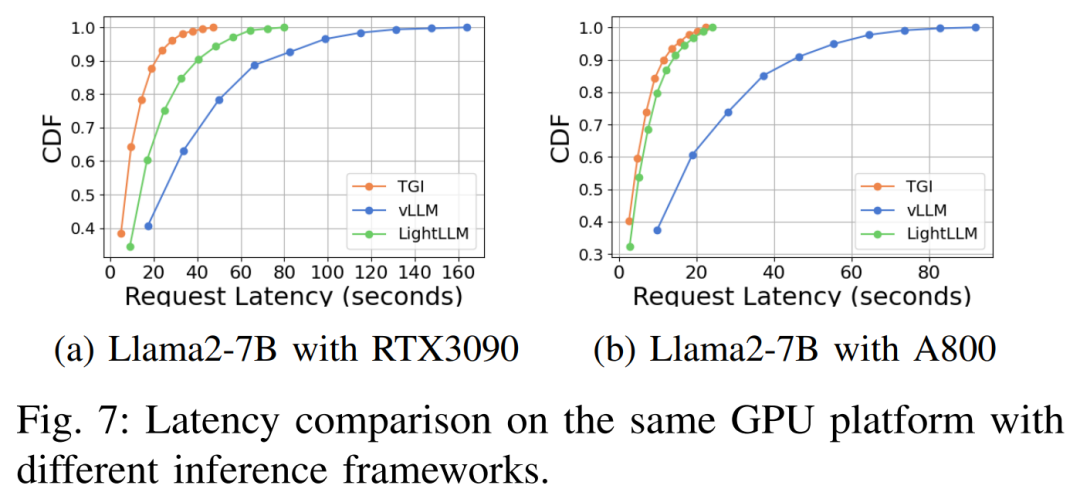
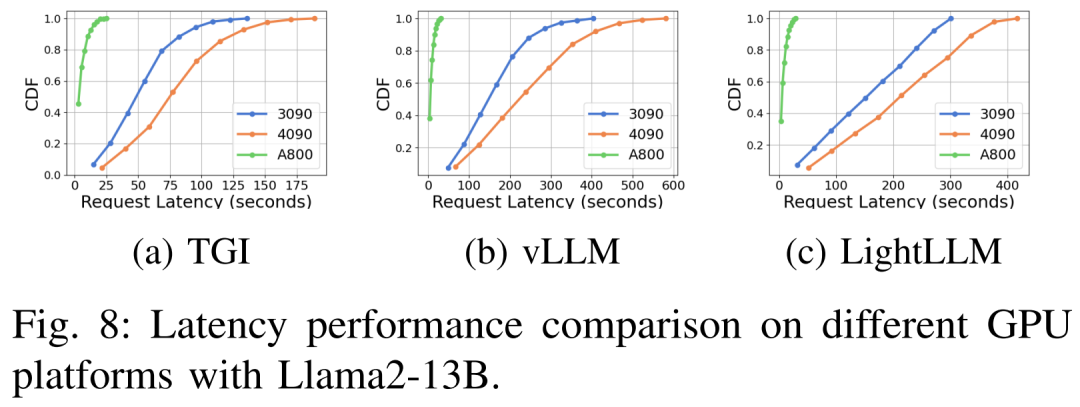
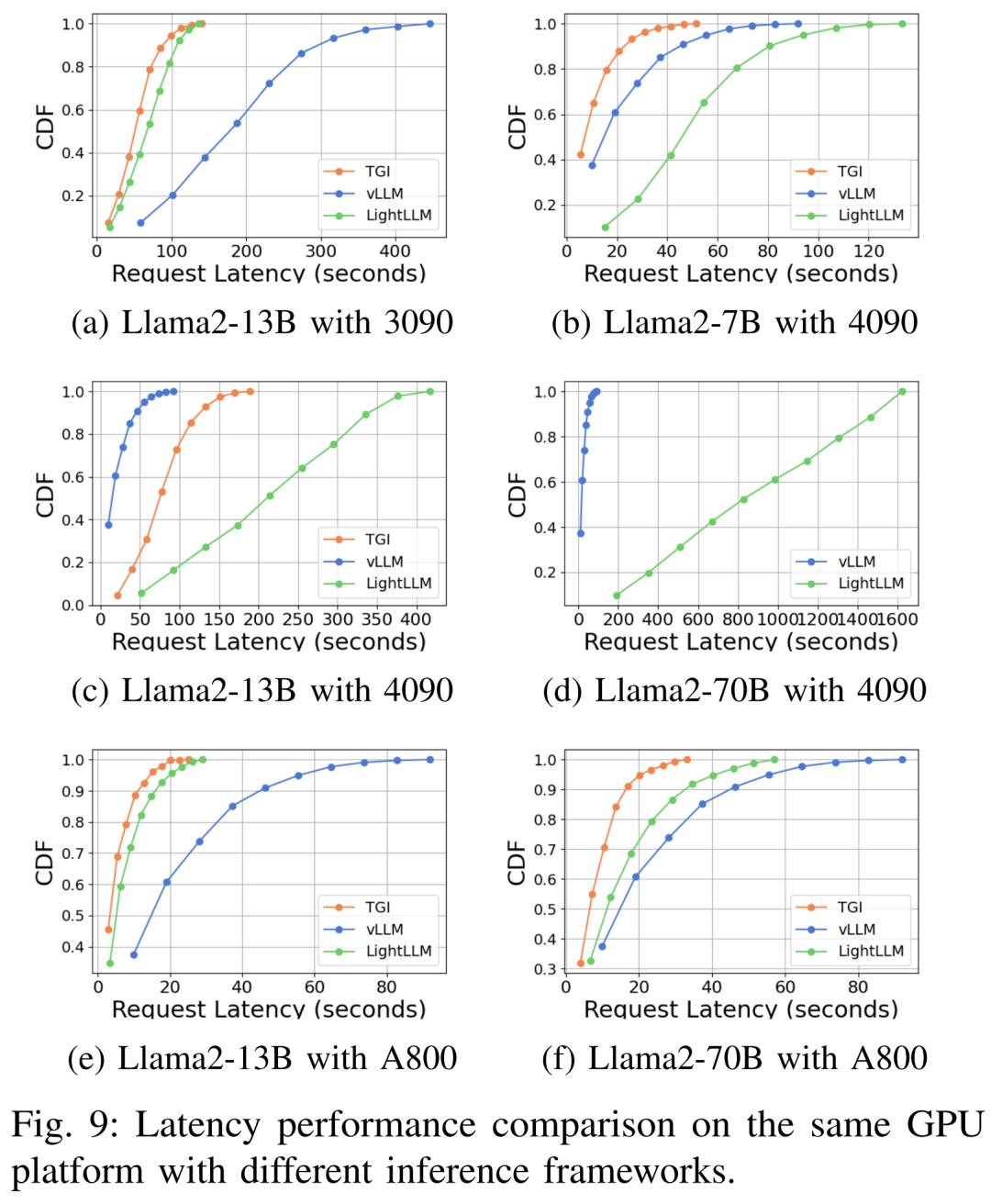
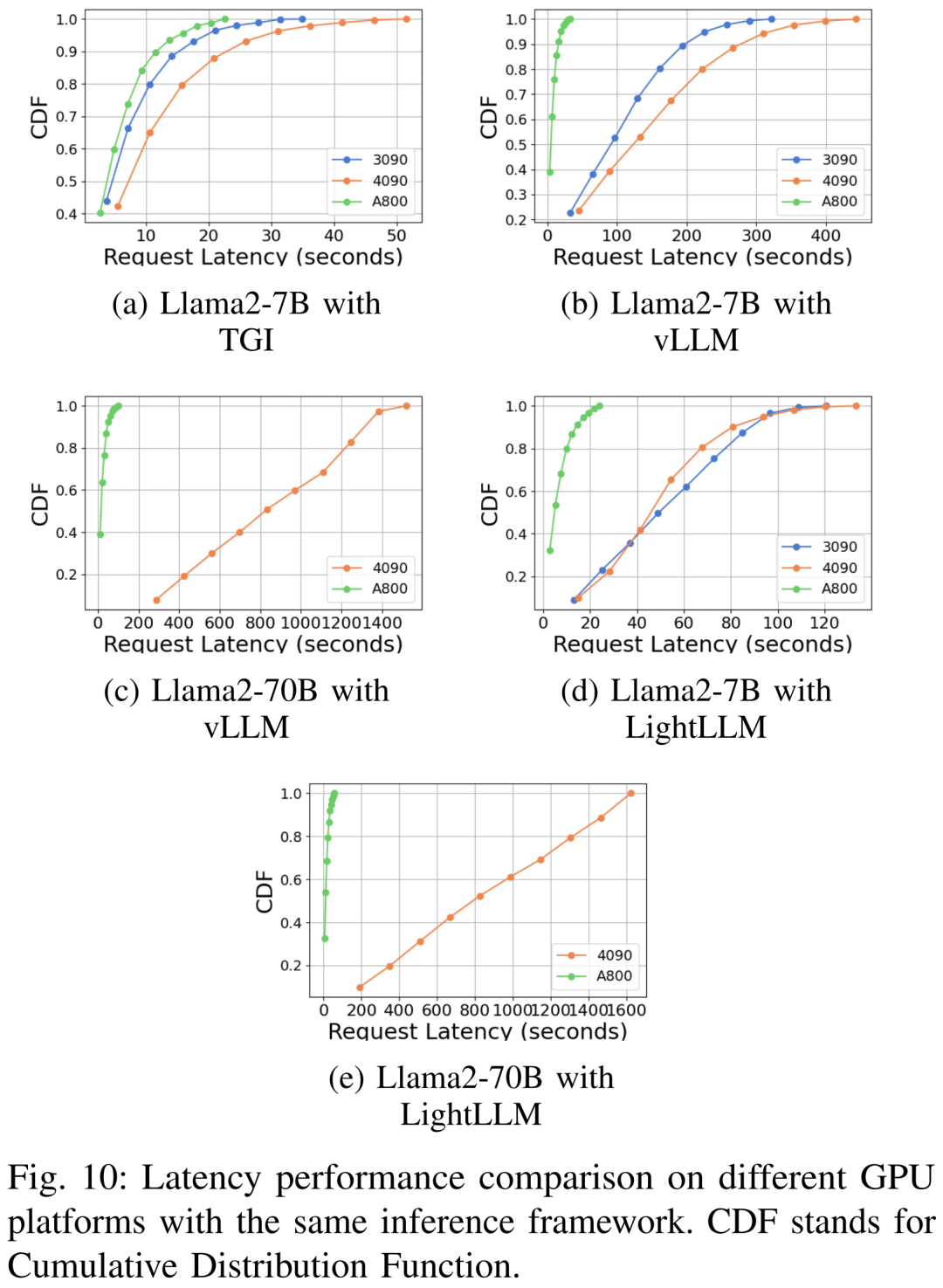
#As shown above, the A800 platform is significantly better than the two consumer-grade platforms RTX4090 and RTX3090 in terms of throughput and latency. And among the two consumer-grade platforms, the RTX3090 has a slight advantage over the RTX4090. The three inference frameworks TGI, vLLM, and LightLLM show no substantial difference in throughput when running on consumer-grade platforms. In comparison, TGI consistently outperforms the other two in terms of latency. On the A800 GPU platform, LightLLM performs best in terms of throughput and its latency is also very close to the TGI framework.
Please refer to the original text for more experimental results
The above is the detailed content of A800 significantly surpasses Llama2 inference RTX3090 and 4090, performing excellent latency and throughput. For more information, please follow other related articles on the PHP Chinese website!

Hot AI Tools

Undresser.AI Undress
AI-powered app for creating realistic nude photos

AI Clothes Remover
Online AI tool for removing clothes from photos.

Undress AI Tool
Undress images for free

Clothoff.io
AI clothes remover

AI Hentai Generator
Generate AI Hentai for free.

Hot Article

Hot Tools

Notepad++7.3.1
Easy-to-use and free code editor

SublimeText3 Chinese version
Chinese version, very easy to use

Zend Studio 13.0.1
Powerful PHP integrated development environment

Dreamweaver CS6
Visual web development tools

SublimeText3 Mac version
God-level code editing software (SublimeText3)

Hot Topics
 Open source! Beyond ZoeDepth! DepthFM: Fast and accurate monocular depth estimation!
Apr 03, 2024 pm 12:04 PM
Open source! Beyond ZoeDepth! DepthFM: Fast and accurate monocular depth estimation!
Apr 03, 2024 pm 12:04 PM
0.What does this article do? We propose DepthFM: a versatile and fast state-of-the-art generative monocular depth estimation model. In addition to traditional depth estimation tasks, DepthFM also demonstrates state-of-the-art capabilities in downstream tasks such as depth inpainting. DepthFM is efficient and can synthesize depth maps within a few inference steps. Let’s read about this work together ~ 1. Paper information title: DepthFM: FastMonocularDepthEstimationwithFlowMatching Author: MingGui, JohannesS.Fischer, UlrichPrestel, PingchuanMa, Dmytr
 The world's most powerful open source MoE model is here, with Chinese capabilities comparable to GPT-4, and the price is only nearly one percent of GPT-4-Turbo
May 07, 2024 pm 04:13 PM
The world's most powerful open source MoE model is here, with Chinese capabilities comparable to GPT-4, and the price is only nearly one percent of GPT-4-Turbo
May 07, 2024 pm 04:13 PM
Imagine an artificial intelligence model that not only has the ability to surpass traditional computing, but also achieves more efficient performance at a lower cost. This is not science fiction, DeepSeek-V2[1], the world’s most powerful open source MoE model is here. DeepSeek-V2 is a powerful mixture of experts (MoE) language model with the characteristics of economical training and efficient inference. It consists of 236B parameters, 21B of which are used to activate each marker. Compared with DeepSeek67B, DeepSeek-V2 has stronger performance, while saving 42.5% of training costs, reducing KV cache by 93.3%, and increasing the maximum generation throughput to 5.76 times. DeepSeek is a company exploring general artificial intelligence
 KAN, which replaces MLP, has been extended to convolution by open source projects
Jun 01, 2024 pm 10:03 PM
KAN, which replaces MLP, has been extended to convolution by open source projects
Jun 01, 2024 pm 10:03 PM
Earlier this month, researchers from MIT and other institutions proposed a very promising alternative to MLP - KAN. KAN outperforms MLP in terms of accuracy and interpretability. And it can outperform MLP running with a larger number of parameters with a very small number of parameters. For example, the authors stated that they used KAN to reproduce DeepMind's results with a smaller network and a higher degree of automation. Specifically, DeepMind's MLP has about 300,000 parameters, while KAN only has about 200 parameters. KAN has a strong mathematical foundation like MLP. MLP is based on the universal approximation theorem, while KAN is based on the Kolmogorov-Arnold representation theorem. As shown in the figure below, KAN has
 Hello, electric Atlas! Boston Dynamics robot comes back to life, 180-degree weird moves scare Musk
Apr 18, 2024 pm 07:58 PM
Hello, electric Atlas! Boston Dynamics robot comes back to life, 180-degree weird moves scare Musk
Apr 18, 2024 pm 07:58 PM
Boston Dynamics Atlas officially enters the era of electric robots! Yesterday, the hydraulic Atlas just "tearfully" withdrew from the stage of history. Today, Boston Dynamics announced that the electric Atlas is on the job. It seems that in the field of commercial humanoid robots, Boston Dynamics is determined to compete with Tesla. After the new video was released, it had already been viewed by more than one million people in just ten hours. The old people leave and new roles appear. This is a historical necessity. There is no doubt that this year is the explosive year of humanoid robots. Netizens commented: The advancement of robots has made this year's opening ceremony look like a human, and the degree of freedom is far greater than that of humans. But is this really not a horror movie? At the beginning of the video, Atlas is lying calmly on the ground, seemingly on his back. What follows is jaw-dropping
 AI subverts mathematical research! Fields Medal winner and Chinese-American mathematician led 11 top-ranked papers | Liked by Terence Tao
Apr 09, 2024 am 11:52 AM
AI subverts mathematical research! Fields Medal winner and Chinese-American mathematician led 11 top-ranked papers | Liked by Terence Tao
Apr 09, 2024 am 11:52 AM
AI is indeed changing mathematics. Recently, Tao Zhexuan, who has been paying close attention to this issue, forwarded the latest issue of "Bulletin of the American Mathematical Society" (Bulletin of the American Mathematical Society). Focusing on the topic "Will machines change mathematics?", many mathematicians expressed their opinions. The whole process was full of sparks, hardcore and exciting. The author has a strong lineup, including Fields Medal winner Akshay Venkatesh, Chinese mathematician Zheng Lejun, NYU computer scientist Ernest Davis and many other well-known scholars in the industry. The world of AI has changed dramatically. You know, many of these articles were submitted a year ago.
 The vitality of super intelligence awakens! But with the arrival of self-updating AI, mothers no longer have to worry about data bottlenecks
Apr 29, 2024 pm 06:55 PM
The vitality of super intelligence awakens! But with the arrival of self-updating AI, mothers no longer have to worry about data bottlenecks
Apr 29, 2024 pm 06:55 PM
I cry to death. The world is madly building big models. The data on the Internet is not enough. It is not enough at all. The training model looks like "The Hunger Games", and AI researchers around the world are worrying about how to feed these data voracious eaters. This problem is particularly prominent in multi-modal tasks. At a time when nothing could be done, a start-up team from the Department of Renmin University of China used its own new model to become the first in China to make "model-generated data feed itself" a reality. Moreover, it is a two-pronged approach on the understanding side and the generation side. Both sides can generate high-quality, multi-modal new data and provide data feedback to the model itself. What is a model? Awaker 1.0, a large multi-modal model that just appeared on the Zhongguancun Forum. Who is the team? Sophon engine. Founded by Gao Yizhao, a doctoral student at Renmin University’s Hillhouse School of Artificial Intelligence.
 Kuaishou version of Sora 'Ke Ling' is open for testing: generates over 120s video, understands physics better, and can accurately model complex movements
Jun 11, 2024 am 09:51 AM
Kuaishou version of Sora 'Ke Ling' is open for testing: generates over 120s video, understands physics better, and can accurately model complex movements
Jun 11, 2024 am 09:51 AM
What? Is Zootopia brought into reality by domestic AI? Exposed together with the video is a new large-scale domestic video generation model called "Keling". Sora uses a similar technical route and combines a number of self-developed technological innovations to produce videos that not only have large and reasonable movements, but also simulate the characteristics of the physical world and have strong conceptual combination capabilities and imagination. According to the data, Keling supports the generation of ultra-long videos of up to 2 minutes at 30fps, with resolutions up to 1080p, and supports multiple aspect ratios. Another important point is that Keling is not a demo or video result demonstration released by the laboratory, but a product-level application launched by Kuaishou, a leading player in the short video field. Moreover, the main focus is to be pragmatic, not to write blank checks, and to go online as soon as it is released. The large model of Ke Ling is already available in Kuaiying.
 The U.S. Air Force showcases its first AI fighter jet with high profile! The minister personally conducted the test drive without interfering during the whole process, and 100,000 lines of code were tested for 21 times.
May 07, 2024 pm 05:00 PM
The U.S. Air Force showcases its first AI fighter jet with high profile! The minister personally conducted the test drive without interfering during the whole process, and 100,000 lines of code were tested for 21 times.
May 07, 2024 pm 05:00 PM
Recently, the military circle has been overwhelmed by the news: US military fighter jets can now complete fully automatic air combat using AI. Yes, just recently, the US military’s AI fighter jet was made public for the first time and the mystery was unveiled. The full name of this fighter is the Variable Stability Simulator Test Aircraft (VISTA). It was personally flown by the Secretary of the US Air Force to simulate a one-on-one air battle. On May 2, U.S. Air Force Secretary Frank Kendall took off in an X-62AVISTA at Edwards Air Force Base. Note that during the one-hour flight, all flight actions were completed autonomously by AI! Kendall said - "For the past few decades, we have been thinking about the unlimited potential of autonomous air-to-air combat, but it has always seemed out of reach." However now,





